- Bank of Montreal is the eighth largest bank in North America by assets
- BMO is acquiring Bank of the West to expand its US presence
- Dividend raised by 25% in 2021
- Wall Street consensus outlook is bullish
- Market-implied outlook is bullish to mid-2022 and neutral/slightly bullish for the full year
Bank of Montreal (NYSE:BMO) has recently been in the news for two reasons. First, the company announced plans to acquire Bank of the West to expand its US footprint, primarily in California. Second, BMO raised its dividend by 25% in late 2021.
BMO shares have shot up over the past 12 months, with a 12-month total return of almost 52%. The shares closed at an all-time high of $118.54 on Jan. 18. Prior to COVID-19, the shares were range bound for years. BMO first closed above $78 on Sept. 4, 2014. On Dec. 31, 2019, the shares closed at $77.50.

Source: Investing.com
The shares have delivered a three-year annualized total return of 18.92%, beating the US financial sectors. The iShares US Financials ETF (NYSE:IYF), for example, has returned 15.96% per year over the same period. BMO has underperformed IYF over the past five- and 10-year periods.

Source: Morningstar
With a forward dividend yield of 3.7%, BMO is comparable to other large Canadian banks. Canadian Imperial Bank Of Commerce (NYSE:CM), Royal Bank of Canada (NYSE:RY) and Toronto Dominion Bank (NYSE:TD) yield 4.29%, 3.35% and 3.54%, respectively.
The consensus outlook for BMO earnings growth over the next three to five years is 6.15% per year and the trailing three- and five-year dividend growth rates are 6.9% and 6.5%, respectively. The earnings growth rate can support the continuation of recent years’ dividend growth. Applying the Gordon Growth Model with the forward dividend yield, the expected total return for BMO is 10.2% per year (using the five-year dividend growth rate).
When I last wrote about BMO on Aug. 18, 2021, I gave the shares a bullish rating. The key drivers for the rating were (1) cheap valuation and high dividend yield, (2) bullish consensus rating from Wall Street and (3) a bullish consensus outlook from the options market. BMO closed at $102.27 on Aug. 18 and at $111.43 on Jan. 25, posting a price gain of 9%. The total return (including dividends) over that period is 10.9%. The S&P 500 returned 1.3% (including dividends) over the same period.
While most readers will be familiar with the Wall Street analyst consensus outlook, fewer will have encountered consensus outlooks calculated from the options market. The price of an option on a stock reflects the market’s consensus estimate of the probability that the stock price will rise above (call option) or fall below (put option) a specific level (the option strike price) between now and when the option expires.
By analyzing the prices of call and put options at a range of strike prices, all with the same expiration date, it is possible to calculate a probabilistic price forecast that reconciles all of the options prices. This is called the market-implied outlook and represents the consensus outlook among buyers and sellers of options.
I have updated the market-implied outlook for BMO through 2022 and into early 2023 and I have compared the results to the current Wall Street consensus outlook, as in my previous analysis.
Wall Street Analyst Outlooks For BMO
E-Trade calculates the Wall Street consensus outlook using the views of eight ranked analysts who have published opinions on BMO over the past 90 days. The consensus rating is bullish and the consensus 12-month price target is 9.7% above the current share price. The consensus outlook has been bullish since early 2021.
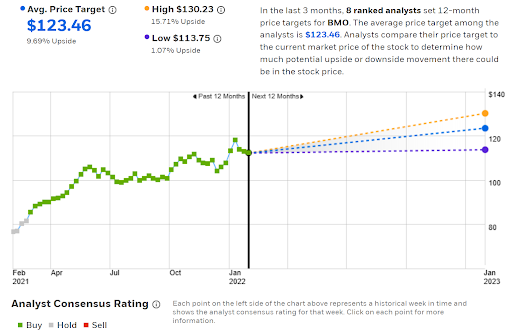
Source: E-Trade
Investing.com combines the views of seven Wall Street analysts to calculate the consensus rating and price target. The consensus rating is bullish and the consensus price target is slightly below the current share price. The Investing.com outlook shows a high dispersion among the individual price targets, ranging from a low of $74 to a high of $168. This is especially notable by contrast with the E-Trade consensus.
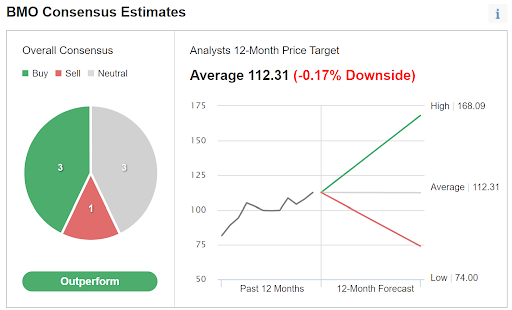
Source: Investing.com
I am inclined to discount the Investing.com consensus results because of the high spread among the price targets. High dispersion in individual analyst price targets reduces confidence in the meaningfulness of the consensus. It is unusual and somewhat surprising to see such different results between these two versions of the consensus. For practical purposes, I typically average consensus price targets, which results in a 4.76% expected price appreciation and 8.46% in total return (including the dividend). The E-Trade consensus outlook indicates an expected total return of 13.4%. For context, the trailing 10-year total return is 9.15% per year and the trailing three-year total return is 18.9% per year.
Market-Implied Outlook For BMO
I have generated the market-implied outlook for BMO to the middle of 2022 (using options that expire on June 17, 2022) and for the next 11.6 months (using options that expire on Jan. 20, 2023). I chose these two option expiration dates to give a view to mid-2022 and for a period that is close to 12 months. In addition, equity options expiring in June and January tend to be among the most traded. Even so, the volume of trading and current open interest on BMO options is very low, which suggests that the market-implied outlook may be of limited value in reflecting market sentiment.
The standard presentation of the market-implied outlook is in the form of a probability distribution of price return, with probability on the vertical axis and return on the horizontal.
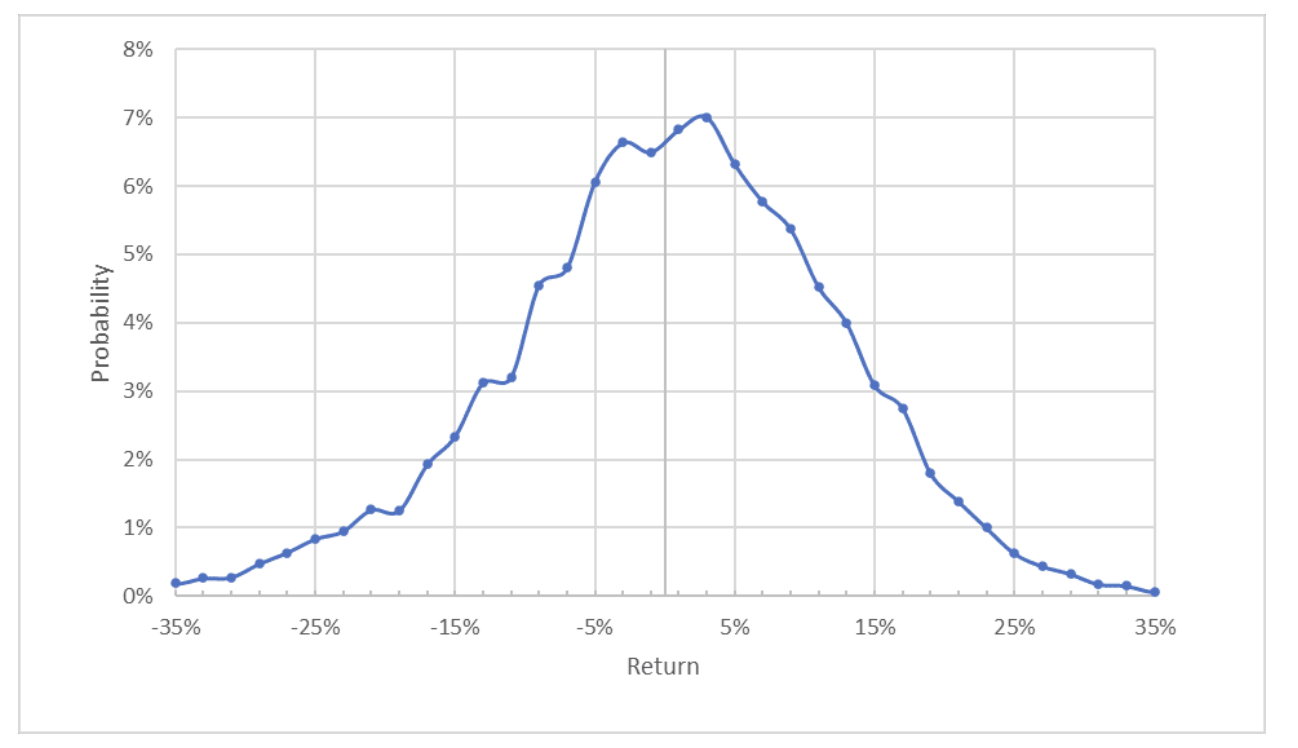
Source: Author’s calculations using options quotes from E-Trade
The market-implied outlook to June 17, 2022, is generally symmetric, with similar probabilities of positive and negative returns of the same magnitude. The maximum-probability outcomes slightly favor positive price returns and the peak probability corresponds to a price return of +3%. The annualized volatility calculated from this distribution is 25%. This is a low volatility, albeit somewhat higher than the value of 21% from my analysis in August. The higher expected volatility is largely, if not entirely, attributable to the rise in overall market volatility over this period.
To make it easier to directly compare the probabilities of positive and negative returns, I rotate the negative return side of the distribution about the vertical axis (see chart below).
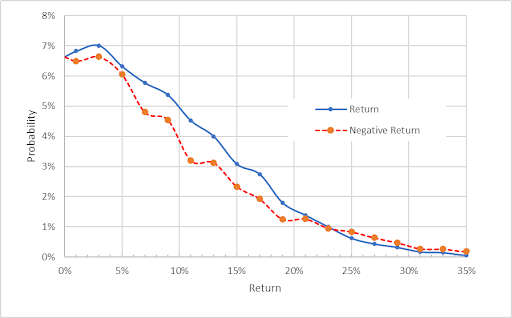
Source: Author’s calculations using options quotes from E-Trade
This view shows that the probabilities of positive returns are consistently higher than for negative returns of the same magnitude for a wide range of the most probable outcomes (the solid blue line is above the dashed red line over the left two-thirds of the chart above). This is a bullish outlook for BMO.
Theory suggests that the market-implied outlook will tend to have a negative bias, as compared with investors’ actual outlooks, because risk-averse investors will pay more than the fair value of downside protection (e.g. put options). There is no way to robustly measure this potential bias, but considering the potential makes this market-implied outlook look more bullish.
The market-implied outlook for BMO for (almost) the next 12 months (calculated using options that expire on Jan. 20, 2023) is somewhat different from the view to the middle of 2022. The probabilities of positive and negative returns match very closely over almost all of the possible outcomes (the dashed red line and the solid blue line are very close to one another). There is a small range of low-magnitude returns for which the probability of negative returns is slightly elevated. I interpret this market-implied outlook to be in the range from neutral to slightly bullish. The expected annualized volatility is 23%.
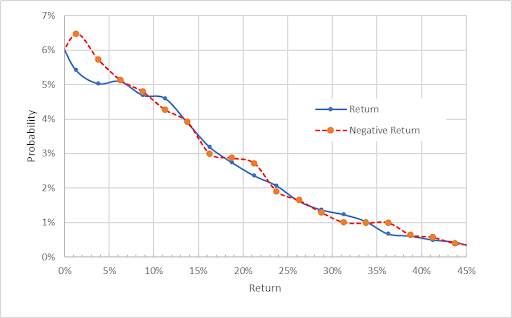
Source: Author’s calculations using options quotes from E-Trade
The market-implied outlooks for BMO indicate a favorable outlook, with a bullish view to the middle of the year and a neutral / slightly bullish view for the next 12 months. Given the low level of options trading for BMO, as noted previously, I don’t put a great deal of weight on the nuances of these outlooks.
Summary
BMO will appeal primarily to income investors. With the 3.7% forward yield and the company’s demonstrated commitment to maintaining and growing the dividend, BMO continues to look good. The earnings outlook supports ongoing dividend growth of 6%+ per year.
The Wall Street analyst consensus outlook for BMO is bullish, although there is a meaningful difference between the consensus 12-month price target from E-Trade and the value from Investing.com. The average of the two consensus price targets implies 12-month total return of 8.46%, as compared with 13.4% looking only at the E-Trade consensus. The market-implied outlook for BMO is bullish to the middle of 2022 and neutral to slightly bullish to early 2022.
The expected volatility is tame over this period. Stocks like BMO add stability to an equity portfolio, along with income and reasonable total returns. I refer to this type of stock as providing portfolio ballast. I continue to be bullish on BMO for these attributes.
